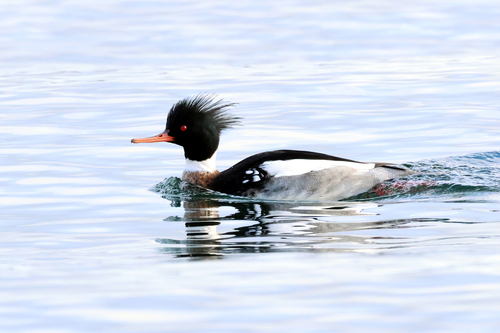
Red-breasted Merganser
The Red-breasted Merganser (*Mergus serrator*) is a striking diving duck known for its slender, serrated bill, perfectly adapted for catching fish. It is a widespread species, found in both freshwater and saltwater environments across the Northern Hemisphere. Unlike many duck species, which are primarily dabblers, the Red-breasted Merganser is a pursuit diver, exhibiting remarkable agility underwater. Its ecological role is primarily that of a predator, helping to control fish populations. It doesn't hold significant cultural significance, but its distinctive appearance and behavior make it a favorite among birdwatchers.
48-62 cm
Length
67-82 cm
Wingspan
Least Concern
Conservation Status
Distribution
The Red-breasted Merganser has a broad distribution, breeding across northern North America, Greenland, Europe, and Asia. It migrates south for the winter, reaching coastal areas of the United States, Mexico, Europe, and eastern Asia. It can be found at a range of altitudes, from sea level to higher-elevation lakes and rivers.
Lifespan
The average lifespan in the wild is not well-documented, but they are known to live over 9 years. Captive individuals may live longer.
Red-breasted Merganser's Habitat
Habitat Types
Coastal waters, Estuaries, Large lakes, Rivers, Bays
Climate Zones
Boreal, Temperate, Subarctic
Adaptations
Their serrated bill is a key adaptation for grasping slippery fish. Dense, waterproof plumage provides insulation in cold water. They also possess salt glands, allowing them to excrete excess salt when inhabiting marine environments. *Consult a professional for medical or expert advice regarding salt glands.*
Variations
While generally considered monotypic (no recognized subspecies), some slight regional variations in size and plumage coloration have been observed, but these are not typically considered distinct enough to warrant subspecies classification.
Appearance
Breeding Plumage
Breeding males have a striking green-black head, a white neck, a reddish-brown breast, and gray flanks. Females and non-breeding males have a grayish-brown body and a reddish-brown head. Both sexes have a distinctive shaggy crest.
Seasonal Feather Changes
Males undergo an eclipse plumage after breeding, resembling females but retaining some distinguishing features. Full breeding plumage is regained in the fall.
Sex Based Plumage Differences
Significant sexual dimorphism is present, especially in breeding plumage. Males are much more brightly colored.
Notable Features
Serrated bill, Shaggy crest, Reddish-brown breast (in breeding males), White wing patches visible in flight
Diet and Feeding
Primary Foods
Small fish, Crustaceans, Aquatic insects, Amphibians
Foraging Behavior
Red-breasted Mergansers are pursuit divers, propelling themselves underwater with their feet to chase prey. They often forage in groups, sometimes herding fish into shallower water.
Specializations
The serrated bill, with its tooth-like projections, is highly specialized for gripping fish. Their streamlined body shape also aids in underwater maneuverability.
Seasonal Diet Variations
Diet varies depending on location and prey availability. In freshwater habitats, they may consume more insects and amphibians, while in saltwater, fish and crustaceans dominate.
Behavior
Social Structure
Red-breasted Mergansers are often found in pairs or small groups during the breeding season. In winter, they can form large flocks, sometimes numbering in the thousands.
Communication
Low croaking calls, Whistles, Visual displays (head-pumping, wing-flapping)
Migration
They are migratory birds, traveling long distances between breeding and wintering grounds. Migration routes are often along coastlines or major river systems. Timing is influenced by weather conditions and ice formation.
Territorial or Group Behaviors
During the breeding season, males defend territories around the nest site. Outside of breeding, they are generally gregarious and form large flocks.
Conservation
Threats
Habitat loss and degradation, Pollution (oil spills, chemical contaminants), Entanglement in fishing gear, Climate change (affecting prey availability and nesting habitat)
Protection Programs
Migratory Bird Treaty Act (in North America), Various international agreements protecting migratory birds, Habitat restoration and protection efforts in some areas
Local National Laws
Protected under various national and international laws, including the Migratory Bird Treaty Act in the United States and Canada.
Population Trend
Stable
Population Estimates
The global population is estimated to be between 1,700,000 and 2,800,000 individuals.
Interesting Facts
They are among the fastest-flying ducks.
Red-breasted Mergansers have been clocked at speeds up to 81 mph (130 km/h) in level flight.
They can dive to depths of over 30 feet.
Although they typically forage in shallower water, they are capable of diving quite deep to pursue prey.
The 'teeth' on their bill are not true teeth.
They are serrations on the edge of the bill, made of keratin, the same material as fingernails.
Faqs about Red-breasted Merganser
What is the difference between a Red-breasted Merganser and a Common Merganser?
While both species have serrated bills, the Red-breasted Merganser male has a reddish-brown breast and a shaggier crest, while the Common Merganser male has a white breast and a smoother crest. Females are more similar, but the Red-breasted Merganser female has a less distinct boundary between the head and neck color.
Are Red-breasted Mergansers good to eat?
Due to their fish-based diet, their flesh is often described as having a strong, fishy flavor and is not typically considered palatable by most people.
Where is the best place to see Red-breasted Mergansers?
During migration and winter, they are commonly seen along coastlines, in bays, and estuaries. During the breeding season, look for them on large lakes and rivers in northern regions.
Copyright @ Nature Style Limited. All Rights Reserved.
 English
English